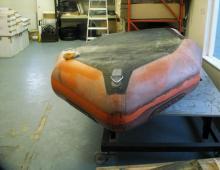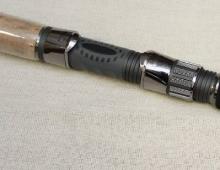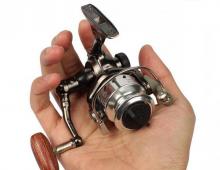Fishhook sizes
Going fishing is not just preparing bait and walking to the pond, it is also preparing gear. The success of the angler depends on the quality of the preparation of the rod and its components.
If we talk about a rod, then for a novice angler a long stick from a deciduous tree, say, from a hazel tree, will do. The selection of fishing line is also important, but in the absence of any, then a nylon or synthetic thread will do.
But problems can arise with a hook, because to make it yourself, if not possible, it will not be very easy. A high-quality hook is the key to successful fishing, as the fish will no longer jump off if it is hooked.
The Importance of Hook Size
It would seem that the choice of size is not such an abstruse exercise - I estimated with an eye for the size of the bait, and it was done, but it was not there.
Maybe a person with experience will succeed in such a trick, but a beginner may not be lucky. The diversity of the market can be confusing, as each detail is important in its own way.
What are they, these fishing hooks?
In general, all hooks are divided into three main types:
- single. This type of hook is the most popular in the world, as it can be used to catch almost any type of fish.
- double. This type of hook is characterized by the presence of two stings and it is perfect for catching predatory fish, where foam rubber fish are used as bait.
Double hooks can be slightly modified by adding a special fastener or an additional small hook for live bait. This step is done for a simple reason - you can’t catch a big fish on a small hook, and if you put a live bait on a big hook, the fish can break loose without clinging tightly.
- triple. In this hook, the stings are placed evenly, every 120 degrees, and are used when spinning large predatory fish on technoplankton.
To this list is added a subclass by purpose:
- carp
- perch
- fly fishing, etc.
There are several basic, most used forms:
- aberdeen;
- liberic;
- crystal;
- kirby;
Not unimportant factor is the presence of the ear. In this classification, the hook may have it or there will be a spatula instead.
The presence of an eye will certainly make it easier to knit a knot and ensure the correct position of the hook in the water. Hooks with a ring are used for fishing on a thick fishing line or braided thread.
There are a lot of interesting knots for a hook with a spatula, but this type of hook is chosen when fishing on a thin monofilament line, no more than 0.16 mm thick. Such hooks are used when catching small fish, weighing no more than 3 kg.
There is also a kind of subtype, a hook without an eye or a spatula - with notches on the forearm.
This type is used when catching fish weighing up to one kilogram, and is very convenient when using the worm as bait, because part of the worm can be pulled over the line and thus hide the metallic sheen of the hook.
The ear can also be different, along the bend towards the sting:
- direct;
- bent inwards;
- bent outward.
An inward-turned eye is the most practical, as it provides a better position of the hook and increases the chances of a good penetration of the stinger into the lip of the fish.
If we talk about the classification of hooks, it is worth noting that there are a lot of variations today, but they are characterized by three main parameters:
- underwear height;
- forearm length;
- hook width;
The length of the forearm depends on the type of fish the fisherman is hunting for. When catching predatory fish, a longer forearm is used so that the fish cannot bite the line.
There are options for hooks with a curved hook, after finishing a part with a forearm, this is very convenient, since the number of fish escapes is reduced, but strength is reduced.
According to the location of the sting, the most common are bent inward, less often straight.
The theory is that a bent hook reduces the percentage of empty bites, but this is applicable if the fish is not accustomed to fishing.
This means that if the fish pecks carefully, then the chances of catching it decrease, compared with a direct sting.
Therefore, in closed and small reservoirs it is better to use a direct sting.
With a sting, you can do another way - bend only the tip of the hook - the situation will be doubly advantageous.
Experienced fishermen, when catching large fish, make a notch on the inside of the hook, slightly below the sting. The people called the notch a beard.
Its main purpose is to reduce the chance of bait coming off during long or fast catching of large fish.
Choosing a hook color is one of the most important steps in preparing for fishing. The color of the hook should be chosen according to the type of bottom color in order to make individual parts less noticeable and focus on the bait, but a shiny hook itself can already be an excellent bait, say, for predatory fish.
Color is an accompanying characteristic that appeared due to the need to protect the hook from the action of water, and, accordingly, metal corrosion.
Distinguish by color:
- nickel, characterized by a bright metallic color;
- blued, or covered with so-called black nickel;
- bronze;
- gilded;
- varnished.
The most expensive coating is gilding, but it protects the hook the most from water. The most practical option is varnishing, due to its low durability.

Choosing a quality hook is a very time-consuming process, since there are only a few companies in the world that make hooks and sell them to distributors, who, in turn, package them and sell them under their own brand.
Price is not necessarily an indicator, since it is not quality that plays a role here, but the productivity of marketers in promoting the brand.
How to catch more fish?
I have been active fishing for quite some time and have found many ways to improve the bite. And here are the most effective ones:- . Attracts fish in cold and warm water with the help of pheromones included in the composition and stimulates their appetite. It's a pity that Rosprirodnadzor wants to ban its sale.
- More sensitive gear. About reviews and instructions for other types of gear you can find on the pages of my site.
- Lures using pheromones.
For production, alloyed or unalloyed carbon steel is used.
When choosing a hook, it is important to evaluate how well it is hardened.
Checking the quality of the hook is quite simple - you need to try to bend it. If it springs, then everything is in order with the metal.
There are options when the hook can bend or even break - such hooks are clearly not of high quality. It is preferable to check the quality right in the store in such a not tricky way.
The second characteristic worth evaluating is the sharpness of the sting. It is checked quite simply - you need to run the tip of the hook over the nail, a thin layer should be removed, otherwise the hook is not of high quality.
Hook thickness is another important parameter to consider. From the correct choice of hook thickness can overestimate the catch.
Attention should be paid to two things: the hook should be hardly noticeable, with any selection of bait, and the thickness of the hook and the thickness of the fishing line must match, or almost match, otherwise fishing will cause a lot of inconvenience.
What size to choose, and most importantly how?
The market is so full of an abundance of hooks that sometimes you can get confused. Each country or region has its own standards, including the designation of the size of fish hooks.
There are quite a few options for standardizing sizes, but the most common are:
- Russian;
- international;
- Finnish;
- Japanese.
Russian standard - everything is simple!
The numbering of the hook size in the Russian version of standardization coincides with the width of the hook - the distance from the forearm to the tip of the hook. This standardization is quite convenient and easy to use.
For foreigners, everything is different, you can’t figure it out right away.
The international classification defies logic as much as the Russian one. Here the size of the hook and the number do not match, and no trend is observed here, except for the reverse increase - the smaller the hook, the larger the number.
Each manufacturer designates its hook with a number in accordance with international requirements.
The width of the hook is not everything - there is also a numbering along the length of the forearm! Selecting the hook width is only half the battle, because it is not the only parameter used in the classification.
An experienced fisherman does not have to peer and touch the hook to determine the width or length of the forearm - these characteristics are printed on the packaging.
As a rule, a sequence of the type is applied on the package: "I No. 5-0.3-12"
The Roman numeral at the beginning informs about the shape of the tackle:
- I- unary with a spatula and a single bend;
- II- unary with a ringlet and a single bend;
- III- single with a spatula and double bends;
- IV- single with a ring and double bends.
The second is the width of the hook in millimeters. The third number indicates the thickness of the wire from which it is made. The fourth is the length of the forearm in millimeters.
| International numbering | Hook width, mm | Domestic numbering | |
| International | Patriotic | ||
| 24 | 1,7 | _ | |
| 22 | 2,0 | - | |
| 20 | 2,2 | - | |
| 19 | 2,4 | - | - |
| 18 | 2,6 | 2,5 | 2,5 |
| 17 | 3,0 | 3,0 | 3 |
| 16 | 3,2 | ||
| 15 | 3,4 | 3,5 | 3,5 |
| 14 | 3,6 | ||
| 13 | 4,0 | 4,0 | 4 |
| 12 | 4,4 | - | |
| 11 | 4,6 | 4,5 | 4,5 |
| 10 | 5,0 | 5,0 | 5 |
| 9 | 5,5 | ||
| 8 | 6,0 | 6,0 | 6 |
| 7 | 6,5 | - | |
| 6 | 7,0 | 7,0 | 7 |
| 5 | 7,5 | 7,5 | 7,5 |
| 4 | 8,0 | 8,0 | 8 |
| 3 | 8,5 | 8,5 | 8,5 |
| 2 | 9,0 | - | |
| 1 | 10,0 | 10.0 | 10 |
Each fish has its own hook!
There is no single rule in choosing a hook. It is important to rely on personal experience, convenience and a lot of related factors.
To summarize, the choice can be made that the larger the fish you are going to catch, the larger the hook you need to take. The remaining subtleties are purely individual and have been described in detail above.
What hook number to catch a certain fish?
 In the domestic classification, numbers from 2 to 5 are used for catching small fish, such as roach.
In the domestic classification, numbers from 2 to 5 are used for catching small fish, such as roach.
The number in this situation varies from the desired size of the fish. The larger the hook, the larger the catch, because it is difficult for a small fish to swallow the bait from a large one.
Starting from numbers 4 to 10, this kind of gear is used for catching medium-sized fish such as bream or large carps.
The pattern from 4 to 10 is similar to the previous version. Numbers 5-7 are the most versatile and best-selling in the world.
Numbers over 10 are used for catching big fish or live bait.
Summarize
The success of fishing depends on the right choice of hook, and there are a lot of subtleties.
The choice should be based on three main objectives:
- hold the bait;
- penetrate the lip of the fish;
- stay on the lip.
The preparation process should also include the preparation of a rod, fishing line, bait, and so on, but it should be understood that the hook must be sharp and close the bait in any case.
Proper selection, taking into account these factors, will allow you not to waste time in vain, but to get a lot of positive emotions from fishing.
Now only I bite!
I caught this pike with a bite activator. No more fishing without a catch and looking for excuses for your bad luck! It's time to change everything!!! The best bite activator of the year! Made in Italy...



